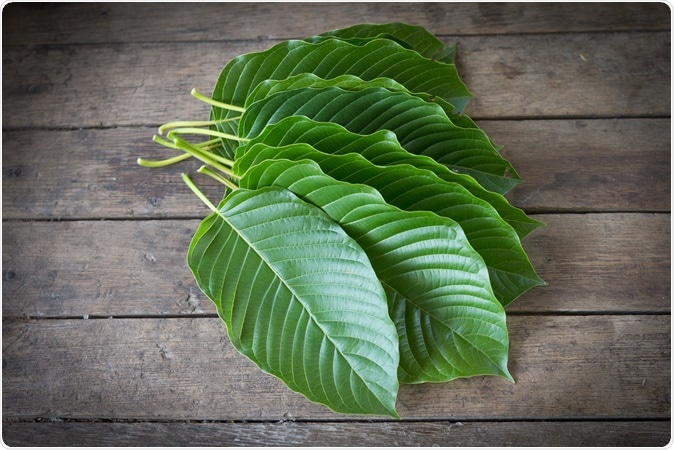The United States Food and Drugs Administration (FDA) has issued a public notice yesterday, 14th November 2017, regarding the risks associated with herbal drug Kratom. Kratom has been used for a long time and still finds numerous users.
The FDA has raised the issue about the potential safety risks associated with this botanical substance. Kratom grows naturally in several Southeast Asian countries such as Thailand, Malaysia, Indonesia and Papua New Guinea. It has been used for centuries by local farmers and populations as part of several herbal remedies. It contains alkaloids mitragynine and 7-hydroxymitragynine that have similar effects as opioids but do not affect breathing of the individual. Exact actions of the compounds present in this plant is not known.

Kratom (Mitragyna speciosa) Mitragynine. Image Credit: frank60 / Shutterstock
Several online websites and shops sell this product in the US claiming that kratom can cure several mental health conditions such as depression, anxiety and pain and also be used as a de-addiction agent. The FDA statement warns that none of these claims are true and use of kratom may cause the health care providers to miss important symptoms and prevent adequate diagnosis and treatment of several conditions.
The FDA statement emphasizes that kratom naturally has similar effects like narcotics and opioids. This means that regular usage of these products can lead to addition and abuse problems. Severe over-dosage may also lead to death. The FDA states that kratom is not only used for medically unapproved indications but also used by a large number of people as a recreational drug because of its euphoria producing actions. Because of the increasing use of opioids as recreational drugs of abuse, another agent available on the market for purchase is of concern says the health agency. FDA Commissioner Scott Gottlieb, said, “The FDA must use its authority to protect the public from addictive substances like kratom, both as part of our commitment to stemming the opioid epidemic and preventing another from taking hold.”
Gottleib goes on to say that kratom is being rampantly used in patients who are addicted to opioid drugs and are experiencing withdrawal symptoms due to stoppage of opioids. They add that there are several approved treatment regiments for patients who have opioid use disorder. Kratom use is unapproved in this condition and may worsen the problem.
The FDA states that there is a ten times rise in the numbers of calls to the U.S. poison control centers regarding kratom between 2010 and 2015. This indicates that kratom use is far from being safe and non-toxic as purported by the sellers. There have been hundreds or reports yearly with 36 reported deaths due to kratom use the FDA notes. Further kratom preparations are being laced with synthetic opioids such as hydrocodone that increase their risk potential. Some of the serious side effects associated with kratom use include live damage, seizures or convulsions and symptoms of opioid withdrawal.
The FDA then says that more investigations and scientific evidence needs to show that kratom use can be helpful in de-addiction from opioids or in other disease conditions such as pain before they can be used by the general public. At present no clear evidence of their safety or benefits is available.
At present the FDA is taking steps to curb the use of kratom by preventing its shipments, conducting seizures, voluntary destruction of kratom containing products etc. Kratom is a controlled substance in several countries including Malaysia, Thailand, Sweden, Germany and Australia. In the US it is banned in Alabama, Arkansas, Indiana, Tennessee and Wisconsin at present.
Reference: https://www.fda.gov/NewsEvents/Newsroom/PressAnnouncements/ucm584970.htm